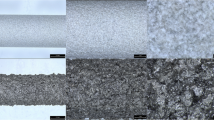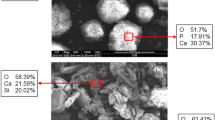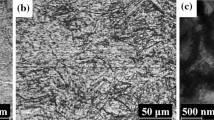Abstract
New technologies, such as selective electron beam melting, allow to create complex interface structures to enhance bone ingrowth in cementless implants. The efficacy of such structures can be tested in animal experiments. Although animal studies provide insight into the biological response of new structures, it remains unclear how ingrowth depth is related to interface strength. Theoretically, there could be a threshold of ingrowth, above which the interface strength does not further increase. To test the relationship between depth and strength we performed a finite element study on micro models with simulated uncoated and hydroxyapatite (HA) coated surfaces. We examined whether complete ingrowth is necessary to obtain a maximal interface strength. An increase in bone ingrowth depth did not always enhance the bone–implant interface strength. For the uncoated specimens a plateau was reached at 1,500 μm of ingrowth depth. For the specimens with a simulated HA coating, a bone ingrowth depth of 500 μm already yielded a substantial interface strength, and deeper ingrowth did not enhance the interface strength considerably. These findings may assist in optimizing interface morphology (its depth) and in judging the effect of bone ingrowth depth on interface strength.





Similar content being viewed by others
References
Brentel AS, de Vasconcellos LM, Oliveira MV, Graca ML, de Vasconcellos LG, Cairo CA, Carvalho YR. Histomorphometric analysis of pure titanium implants with porous surface versus rough surface. J Appl Oral Sci. 2006;14:213–8.
Frosch KH, Barvencik F, Viereck V, Lohmann CH, Dresing K, Breme J, Brunner E, Sturmer KM. Growth behavior, matrix production, and gene expression of human osteoblasts in defined cylindrical titanium channels. J Biomed Mater Res A. 2004;68:325–34.
Jin QM, Takita H, Kohgo T, Atsumi K, Itoh H, Kuboki Y. Effects of geometry of hydroxyapatite as a cell substratum in BMP-induced ectopic bone formation. J Biomed Mater Res. 2000;52:491–9.
Vasconcellos LM, Oliveira MV, Graca ML, Vasconcellos LG, Cairo CA, Carvalho YR. Design of dental implants, influence on the osteogenesis and fixation. J Mater Sci Mater Med. 2008;19:2851–7.
Kujala S, Ryhanen J, Danilov A, Tuukkanen J. Effect of porosity on the osteointegration and bone ingrowth of a weight-bearing nickel–titanium bone graft substitute. Biomaterials. 2003;24:4691–7.
Hulbert SF, Young FA, Mathews RS, Klawitter JJ, Talbert CD, Stelling FH. Potential of ceramic materials as permanently implantable skeletal prostheses. J Biomed Mater Res. 1970;4:433–56.
Itala AI, Ylanen HO, Ekholm C, Karlsson KH, Aro HT. Pore diameter of more than 100 microm is not requisite for bone ingrowth in rabbits. J Biomed Mater Res. 2001;58:679–83.
Kienapfel H, Sprey C, Wilke A, Griss P. Implant fixation by bone ingrowth. J Arthroplast. 1999;14:355–68.
Hollister SJ, Lin CY, Saito E, Lin CY, Schek RD, Taboas JM, Williams JM, Partee B, Flanagan CL, Diggs A, et al. Engineering craniofacial scaffolds. Orthod Craniofac Res. 2005;8:162–73.
Zhang E, Zou C. Porous titanium and silicon-substituted hydroxyapatite biomodification prepared by a biomimetic process: characterization and in vivo evaluation. Acta Biomater. 2009;5:1732–41.
Nguyen HQ, Deporter DA, Pilliar RM, Valiquette N, Yakubovich R. The effect of sol–gel-formed calcium phosphate coatings on bone ingrowth and osteoconductivity of porous-surfaced Ti alloy implants. Biomaterials. 2004;25:865–76.
Wazen RM, Lefebvre LP, Baril E, Nanci A. Initial evaluation of bone ingrowth into a novel porous titanium coating. J Biomed Mater Res B Appl Biomater. 2010;94:64–71.
Soballe K, Hansen ES, Brockstedt-Rasmussen H, Hjortdal VE, Juhl GI, Pedersen CM, Hvid I, Bunger C. Gap healing enhanced by hydroxyapatite coating in dogs. Clin Orthop Relat Res. 1991;272:300–307.
Faeda RS, Tavares HS, Sartori R, Guastaldi AC, Marcantonio E Jr. Biological performance of chemical hydroxyapatite coating associated with implant surface modification by laser beam: biomechanical study in rabbit tibias. J Oral Maxillofac Surg. 2009;67:1706–15.
Heinl P, Muller L, Korner C, Singer RF, Muller FA. Cellular Ti-6Al-4V structures with interconnected macro porosity for bone implants fabricated by selective electron beam melting. Acta Biomater. 2008;4:1536–44.
Li JP, Habibovic P, van den DM, Wilson CE, De W Jr, van Blitterswijk CA, de GK. Bone ingrowth in porous titanium implants produced by 3D fiber deposition. Biomaterials. 2007;28:2810–20.
Biemond JE, Hannink G, Jurrius A, Verdonschot N, Buma P. In vivo assessment of bone ingrowth potential of 3-dimensional E-beam produced implant surfaces and the effect of additional treatment by acid-etching and hydroxyapatite coating. J Biomater Appl. 2010;95(1):131–140.
Buser D, Nydegger T, Oxland T, Cochran DL, Schenk RK, Hirt HP, Snetivy D, Nolte LP. Interface shear strength of titanium implants with a sandblasted and acid-etched surface: a biomechanical study in the maxilla of miniature pigs. J Biomed Mater Res. 1999;45:75–83.
Bobyn JD, Stackpool GJ, Hacking SA, Tanzer M, Krygier JJ. Characteristics of bone ingrowth and interface mechanics of a new porous tantalum biomaterial. J Bone Joint Surg Br. 1999;81:907–14.
Majumdar S, Kothari M, Augat P, Newitt DC, Link TM, Lin JC, Lang T, Lu Y, Genant HK. High-resolution magnetic resonance imaging: three-dimensional trabecular bone architecture and biomechanical properties. Bone. 1998;22:445–54.
Waanders D, Janssen D, Mann KA, Verdonschot N. The mechanical effects of different levels of cement penetration at the cement–bone interface. J Biomech. 2010;43:1167–75.
Rho JY, Ashman RB, Turner CH. Young’s modulus of trabecular and cortical bone material: ultrasonic and microtensile measurements. J Biomech. 1993;26:111–9.
Stolk J, Verdonschot N, Murphy BP, Prendergast PJ, Huiskes R. Finite element simulation of anisotropic damage accumulation and creep in acrylic bone cement. Eng Fract Mech. 2004;71:513–28.
Keyak JH, Kaneko TS, Tehranzadeh J, Skinner HB. Predicting proximal femoral strength using structural engineering models. Clin Orthop Relat Res. 2005;437:219–228.
Rancourt D, Shirazi-Adl A, Drouin G, Paiement G. Friction properties of the interface between porous-surfaced metals and tibial cancellous bone. J Biomed Mater Res. 1990;24:1503–19.
Janssen D, Mann KA, Verdonschot N. Micro-mechanical modeling of the cement–bone interface: the effect of friction, morphology and material properties on the micromechanical response. J Biomech. 2008;41:3158–63.
Lin H, Xu H, Zhang X, de GK. Tensile tests of interface between bone and plasma-sprayed HA coating-titanium implant. J Biomed Mater Res. 1998;43:113–22.
Probster L, Voigt C, Fuhrmann G, Gross UM. Tensile and torsional shear-strength of the bone implant interface of titanium implants in the rabbit. J Mater Sci Mater Med. 1994;5:314–9.
Acknowledgments
This study was partly sponsored by Eurocoating SpA (Trento, Italy) and “Provincia Autonoma di Trento” under the project called “E-Ortho”. The authors would like to thank Pierfrancesco Robotti and Emanuele Magalini (Eurocoating, Trento, Italy), who actively participated in this study and provided the CT scan of the EBM produced structures.
Author information
Authors and Affiliations
Corresponding author
Rights and permissions
About this article
Cite this article
Tarala, M., Waanders, D., Biemond, J.E. et al. The effect of bone ingrowth depth on the tensile and shear strength of the implant–bone e-beam produced interface. J Mater Sci: Mater Med 22, 2339 (2011). https://doi.org/10.1007/s10856-011-4419-z
Received:
Accepted:
Published:
DOI: https://doi.org/10.1007/s10856-011-4419-z




